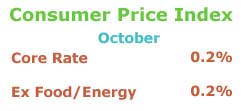|
Inflation remains tame
|
 |
November 17, 1999: 1:06 p.m. ET
Consumer prices rise an expected 0.2% in October; housing starts up 0.1%
By Staff Writer M. Corey Goldman
|
NEW YORK (CNNfn) - U.S. consumer prices rose in October at the slowest pace in four months, the government said Wednesday, matching analysts' expectations and indicating inflation at the retail level remains benign.
The Consumer Price Index, the government's main inflation gauge, rose 0.2 percent in October, both including and excluding more volatile food and energy prices, the Labor Department said. The figures matched economists' consensus estimates.
The report, out less than a day after the Federal Reserve lifted short-term interest rates as a hedge against accelerating inflation, confirmed for analysts and investors that the U.S. economy continues to chug along at a pace that isn't boosting prices for goods and services.
Low and steady
"Despite a robust economy and tight labor markets, inflation is still low and steady," said Steven Wood, a senior economist at Banc of America Securities based in San Francisco. "These data provide some relief for the Federal Open Market Committee."

The overall index gained 2.6 percent from a year earlier while the core rate rose 2.1 percent, the report said, close to its 1.9 percent August gain, which was the smallest in 33 years. Clothing was one of the few categories showing a significant increase, rising 0.6 percent on the month. Food prices gained 0.2 percent while energy costs eased 0.1 percent.
Moderating housing activity?
Two other reports released Wednesday indicated robust housing activity, though not significantly stronger than previous months' levels, advancing the case among analysts that the red-hot housing market may be starting to cool off.
The Commerce Department said housing starts rose 0.1 percent to a 1.63 million annual rate last month, countering a revised 1.8 percent decline in September. Building permits, meantime, a measure of builders' future expectations, gained 5.2 percent to a 1.58 million rate, above the 1.51 million rate in September.
That is good news for financial markets since it suggests economic activity is leveling off, said Ian Shepherdson, chief U.S. economist at High Frequency Economics. Consumer spending accounts for about two-thirds of economic output.
"Clearly this means that housing activity is no
longer adding incrementally to economic growth," Shepherdson said. "Eventually, the housing slowdown will affect retail sales too, but that is probably a story for the spring of next year, at the earliest."

Is housing activity tapering off?
Starts on single-family homes rose to 1.33 million units while starts on multiple units dipped to 303,000. Strength was seen across the country except for the West, where starts slowed 5.7 percent to 365,000 units. Starts in the Northeast rose 4 percent to 130,000, starts in the South gained 2.4 percent to 755,000, and in the Midwest starts rose 0.3 percent to 378,000.
Bond traders chose to interpret the numbers as a sign that housing activity remains strong. Evidence of strong growth and potential inflation pressures typically lead investors to sell bonds, whose value is eroded by accelerating inflation.
Bonds extend losses
The Treasury's 30-year bond extended earlier losses, falling almost a full point in price and pushing up its yield to 6.12 percent from 6.06 percent Tuesday. Stocks were less affected, with the Dow Jones industrial average almost unchanged at midday.
The Fed's policy-making arm Tuesday raised its target interest rate for overnight loans between banks to 5.5 percent from 5.25 percent, the third increase this year. The rate rise reversed the last of three cuts implemented last fall in the wake of Russia's debt crisis and Asia's economic woes.
Click here for CNNfn.com's Special Report: Eyes on the Fed
Still, in their announcement following Tuesday's rate hike, policy-makers warned that a shrinking pool of available workers could cause inflation to bubble up if companies start paying higher wages to retain employees or attract new ones.
In another report, the government said U.S. workers' average weekly earnings rose an inflation-adjusted 0.5 percent in October, countering a 0.4 percent dip the month before. Inflation-adjusted earnings were 0.8 percent higher in October than a year ago.
Will the economy slow?
To be sure, Wednesday's inflation report provides additional ammunition to Wall Street's "New Paradigm" pundits, who expect inflation to remain benign and the U.S. economy to slow to a more reasonable pace by the first quarter of the new year.
At the same time, a significant number of analysts and economists remain unconvinced by the recent spate of numbers -- tempered factory orders, rising inventories, subdued consumer spending -- that the Fed has finished tinkering with the economy.
"While Fed policy is probably on hold until at least February, Tuesday's rate hike may not be the last, unless clear signs of slowing in the economy and labor market loosening emerge," said Kim Rupert, an analyst at Standard & Poor's MMS in San Francisco. "The FOMC's focus on the tight labor market will keep the statistics at the forefront." 
|
|
|
|
|
 |

|

